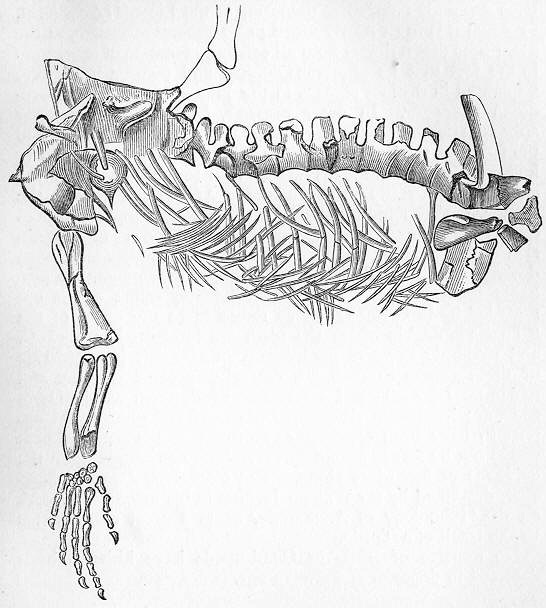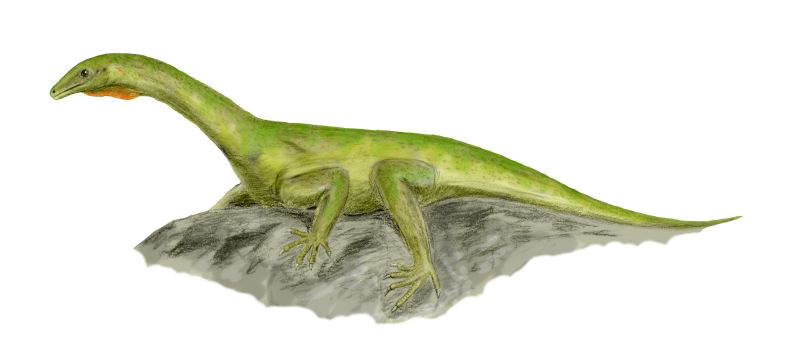Protorosaurus Speneri on:
[Wikipedia]
[Google]
[Amazon]
''Protorosaurus'' ("first lizard") is a genus of lizard-like early reptiles. Members of the genus lived during the late
 ''Protorosaurus'' was one of the first fossil reptiles to be described, being initially described in Latin in 1710 by from a specimen found in
''Protorosaurus'' was one of the first fossil reptiles to be described, being initially described in Latin in 1710 by from a specimen found in
 Stomach contents of a specimen of ''Protorosaurus'' show the presence of numerous ovules of the locally common voltzialean conifer '' Ullmannia frumentaria'', which was unexpected given its unspecialised dentiton of conical and unserrated teeth, which were assumed to represent a predatory lifestyle. Along with the coniferous ovules, several rounded pebbles were found in the body cavity, these may have functioned as
Stomach contents of a specimen of ''Protorosaurus'' show the presence of numerous ovules of the locally common voltzialean conifer '' Ullmannia frumentaria'', which was unexpected given its unspecialised dentiton of conical and unserrated teeth, which were assumed to represent a predatory lifestyle. Along with the coniferous ovules, several rounded pebbles were found in the body cavity, these may have functioned as
 The Kupferschiefer and equivalent Marl Slate is a marine unit that forms part of the
The Kupferschiefer and equivalent Marl Slate is a marine unit that forms part of the
Permian
The Permian ( ) is a geologic period and System (stratigraphy), stratigraphic system which spans 47 million years from the end of the Carboniferous Period million years ago (Mya), to the beginning of the Triassic Period 251.9 Mya. It is the last ...
period in what is now Germany
Germany,, officially the Federal Republic of Germany, is a country in Central Europe. It is the second most populous country in Europe after Russia, and the most populous member state of the European Union. Germany is situated betwe ...
and Great Britain
Great Britain is an island in the North Atlantic Ocean off the northwest coast of continental Europe. With an area of , it is the largest of the British Isles, the largest European island and the ninth-largest island in the world. It i ...
. Once believed to have been an ancestor to lizards, ''Protorosaurus'' is now known to be one of the oldest and most primitive members of Archosauromorpha, the group that would eventually lead to archosaurs such as crocodilians and dinosaur
Dinosaurs are a diverse group of reptiles of the clade Dinosauria. They first appeared during the Triassic period, between 243 and 233.23 million years ago (mya), although the exact origin and timing of the evolution of dinosaurs is t ...
s.
Description
''Protorosaurus'' grew up to in length, and was a slender, lizard-like animal, vaguely resembling a monitor lizard, with long legs and a long neck.Discovery
 ''Protorosaurus'' was one of the first fossil reptiles to be described, being initially described in Latin in 1710 by from a specimen found in
''Protorosaurus'' was one of the first fossil reptiles to be described, being initially described in Latin in 1710 by from a specimen found in Thuringia
Thuringia (; german: Thüringen ), officially the Free State of Thuringia ( ), is a state of central Germany, covering , the sixth smallest of the sixteen German states. It has a population of about 2.1 million.
Erfurt is the capital and lar ...
in Germany, who considered the animal to be a crocodile, and most similar to the Nile crocodile
The Nile crocodile (''Crocodylus niloticus'') is a large crocodilian native to freshwater habitats in Africa, where it is present in 26 countries. It is widely distributed throughout sub-Saharan Africa, occurring mostly in the central, eastern, ...
(''C. niloticus''). Over a century later, in publications in 1830 and 1832 Hermann von Meyer
Christian Erich Hermann von Meyer (3 September 1801 – 2 April 1869), known as Hermann von Meyer, was a German palaeontologist. He was awarded the 1858 Wollaston medal by the Geological Society of London.
Life
He was born at Frankfurt am Ma ...
recognised ''Protorosaurus'' as distinct extinct reptile and gave it a formal species description, dedicating an extensive monograph to it in 1856. In 1871 Thomas Henry Huxley
Thomas Henry Huxley (4 May 1825 – 29 June 1895) was an English biologist and anthropologist specialising in comparative anatomy. He has become known as "Darwin's Bulldog" for his advocacy of Charles Darwin's theory of evolution.
The stori ...
erected the clade Protorosauria
Protorosauria is an extinct polyphyletic group of archosauromorph reptiles from the latest Middle Permian ( Capitanian stage) to the end of the Late Triassic (Rhaetian stage) of Asia, Europe and North America. It was named by the English anatom ...
, with ''Protorosaurus'' as the only member. The German specimens were found in the Kupferschiefer a widespread unit of Late Permian (likely Wuchiapingian
In the geologic timescale, the Wuchiapingian or Wujiapingian (from in the Liangshan area of Hanzhong, Shaanxi Province) is an age or stage of the Permian. It is also the lower or earlier of two subdivisions of the Lopingian Epoch or Series. Th ...
) age.
In 1914, a new ceratopsian
Ceratopsia or Ceratopia ( or ; Greek: "horned faces") is a group of herbivorous, beaked dinosaurs that thrived in what are now North America, Europe, and Asia, during the Cretaceous Period, although ancestral forms lived earlier, in the Jurassic ...
dinosaur found by Lawrence Lambe
Lawrence Morris Lambe (August 27, 1863 – March 12, 1919) was a Canadian geologist, palaeontologist, and ecologist from the Geological Survey of Canada (GSC).
His published work, describing the diverse and plentiful dinosaur discoveries from th ...
was again given the name ''Protorosaurus'' (in this sense meaning "before ''Torosaurus
''Torosaurus'' ("perforated lizard", in reference to the large openings in its frill) is a genus of herbivorous ceratopsid dinosaur that lived during the late Maastrichtian stage of the Cretaceous period, between 68 and 66 million years ago, th ...
''"). When Lambe found that the name had already been used for the early archosauromorph, he renamed his ceratopsian ''Chasmosaurus
''Chasmosaurus'' ( ) is a genus of ceratopsid dinosaur from the Upper Cretaceous Period of North America. Its name means 'opening lizard', referring to the large openings ( fenestrae) in its frill (Greek ''chasma'' meaning 'opening' or 'hollow' ...
''.
In 1870, a new species, ''Protorosaurus huxleyi'' was described from a railway cutting near Middridge
Middridge is a village in County Durham, North East England. It is situated east of Shildon and north-west of Newton Aycliffe. The village is situated near a quarry that was mined by the people many generations ago. There is one public house in ...
in County Durham in northern England, in sediments belonging to the Marl Slate, a unit that is equivalent to the Kupferschiefer, however it was later shown that this specimen was not ''Protorosaurus'', and it was subsequently placed in the new genus '' Adelosaurus''. In 1993, a specimen of ''Protorosaurus'' was described from Quarrington Quarry also in County Durham, in sediments of the Marl Slate. This skeleton included fragments of the skull that had not previously been known. A thorough redescription of ''Protorosaurus'' was published in 2009, including a specimen with a complete skull.
Paleobiology
 Stomach contents of a specimen of ''Protorosaurus'' show the presence of numerous ovules of the locally common voltzialean conifer '' Ullmannia frumentaria'', which was unexpected given its unspecialised dentiton of conical and unserrated teeth, which were assumed to represent a predatory lifestyle. Along with the coniferous ovules, several rounded pebbles were found in the body cavity, these may have functioned as
Stomach contents of a specimen of ''Protorosaurus'' show the presence of numerous ovules of the locally common voltzialean conifer '' Ullmannia frumentaria'', which was unexpected given its unspecialised dentiton of conical and unserrated teeth, which were assumed to represent a predatory lifestyle. Along with the coniferous ovules, several rounded pebbles were found in the body cavity, these may have functioned as gastroliths
A gastrolith, also called a stomach stone or gizzard stone, is a rock held inside a gastrointestinal tract. Gastroliths in some species are retained in the muscular gizzard and used to grind food in animals lacking suitable grinding teeth. In oth ...
.
Relationships
''Protorosaurus'' has been suggested to be closely related to '' Czatkowiella'' from the Early Triassic of Poland, but the remains of ''Czatkowiella'' are fragmentary and mixed in with those of other reptiles, so it is possible that the taxon is a chimaera. In a comprehensive analysis of "Protorosauria" in 2021, ''Protorosaurus'' was consistently recovered as the earliest diverging member of Archosauromorpha. The cladogram below follows an analysis by Ezcurra (2016), and highlights the position of ''Protorosaurus'' among other early archosauromorph reptiles.Paleoenvironment
 The Kupferschiefer and equivalent Marl Slate is a marine unit that forms part of the
The Kupferschiefer and equivalent Marl Slate is a marine unit that forms part of the Zechstein
The Zechstein (German either from ''mine stone'' or ''tough stone'') is a unit of sedimentary rock layers of Middle to Late Permian (Guadalupian to Lopingian) age located in the European Permian Basin which stretches from the east coast of Englan ...
, a sequence of rocks formed on the edge of the Zechstein Sea, a large inland shallow sea that existed in Northern Europe during the Late Permian. The environment at the time of deposition is considered to have been semi-arid
A semi-arid climate, semi-desert climate, or steppe climate is a dry climate sub-type. It is located on regions that receive precipitation below potential evapotranspiration, but not as low as a desert climate. There are different kinds of semi- ...
. The terrestrial flora of the Zechstein is dominated by conifers, with seed ferns also being common, while taeniopterids, ginkgophytes and sphenophytes are rare. Other terrestrial vertebrates found in the Kupfershiefer and lower Zechstein include the gliding weigeltisaurid reptiles ''Weigeltisaurus
''Weigeltisaurus'' is an extinct genus of weigeltisaurid reptile from the Late Permian Kupferschiefer of Germany and Marl Slate of England. It has a single species, originally named as ''Palaechamaeleo jaekeli'' in 1930 and later assigned the na ...
'' and ''Glaurung
J. R. R. Tolkien's Middle-earth legendarium features dragons based on those of European legend, but going beyond them in having personalities of their own, such as the wily Smaug, who has features of both Fafnir and the ''Beowulf'' dragon. ...
,'' the pareiasaur '' Parasaurus,'' the cynodont ''Procynosuchus
''Procynosuchus'' (Greek: "Before dog crocodile") is an extinct genus of cynodonts from the Late Permian. It is considered to be one of the earliest and most basal cynodonts. It was 60 cm (2 ft) long.
Remains of ''Procynosuchus'' have ...
,'' and indeterminate captorhinids, dicynodont
Dicynodontia is an extinct clade of anomodonts, an extinct type of non-mammalian therapsid. Dicynodonts were herbivorous animals with a pair of tusks, hence their name, which means 'two dog tooth'. Members of the group possessed a horny, typic ...
s, and dissorophid temnospondyls
Temnospondyli (from Greek τέμνειν, ''temnein'' 'to cut' and σπόνδυλος, ''spondylos'' 'vertebra') is a diverse order of small to giant tetrapods—often considered primitive amphibians—that flourished worldwide during the Carbo ...
.
References
{{Taxonbar, from=Q134702 Prehistoric reptile genera Lopingian life Prehistoric archosauromorphs Permian reptiles of Europe Permian Germany Fossils of Germany Kupferschiefer Fossil taxa described in 1830 Taxa named by Christian Erich Hermann von Meyer